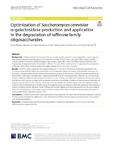| dc.contributor.author | Álvarez Cao, María E. | |
| dc.contributor.author | Cerdán, María Esperanza | |
| dc.contributor.author | González-Siso, María-Isabel | |
| dc.contributor.author | Becerra, Manuel | |
| dc.date.accessioned | 2020-01-28T09:44:10Z | |
| dc.date.available | 2020-01-28T09:44:10Z | |
| dc.date.issued | 2019-10-10 | |
| dc.identifier.citation | Álvarez-Cao, M., Cerdán, M., González-Siso, M. et al. Optimization of Saccharomyces cerevisiae α-galactosidase production and application in the degradation of raffinose family oligosaccharides. Microb Cell Fact 18, 172 (2019). https://doi.org/10.1186/s12934-019-1222-x | es_ES |
| dc.identifier.issn | 1475-2859 | |
| dc.identifier.uri | http://hdl.handle.net/2183/24765 | |
| dc.description.abstract | [Abstract]
Background: α-Galactosidases are enzymes that act on galactosides present in many vegetables, mainly legumes and cereals, have growing importance with respect to our diet. For this reason, the use of their catalytic activity is of great interest in numerous biotechnological applications, especially those in the food industry directed to the degradation of oligosaccharides derived from raffinose. The aim of this work has been to optimize the recombinant production and further characterization of α-galactosidase of Saccharomyces cerevisiae.
Results: The MEL1 gene coding for the α-galactosidase of S. cerevisiae (ScAGal) was cloned and expressed in the S. cerevisiae strain BJ3505. Different constructions were designed to obtain the degree of purification necessary for enzymatic characterization and to improve the productive process of the enzyme. ScAGal has greater specificity for the synthetic substrate p-nitrophenyl-α-D-galactopyranoside than for natural substrates, followed by the natural glycosides, melibiose, raffinose and stachyose; it only acts on locust bean gum after prior treatment with β-mannosidase. Furthermore, this enzyme strongly resists proteases, and shows remarkable activation in their presence. Hydrolysis of galactose bonds linked to terminal non-reducing mannose residues of synthetic galactomannan-oligosaccharides confirms that ScAGal belongs to the first group of α-galactosidases, according to substrate specificity. Optimization of culture conditions by the statistical model of Response Surface helped to improve the productivity by up to tenfold when the concentration of the carbon source and the aeration of the culture medium was increased, and up to 20 times to extend the cultivation time to 216 h.
Conclusions: ScAGal characteristics and improvement in productivity that have been achieved contribute in making ScAGal a good candidate for application in the elimination of raffinose family oligosaccharides found in many products of the food industry. | es_ES |
| dc.description.sponsorship | Xunta de Galicia; ED431C 2016–012 | es_ES |
| dc.language.iso | eng | es_ES |
| dc.publisher | BMC | es_ES |
| dc.relation.uri | https://doi.org/10.1186/s12934-019-1222-x | es_ES |
| dc.rights | Atribución 4.0 España | es_ES |
| dc.rights.uri | http://creativecommons.org/licenses/by/4.0/es/ | * |
| dc.subject | α-Galactosidase | es_ES |
| dc.subject | Biochemical characterization | es_ES |
| dc.subject | Production optimization | es_ES |
| dc.subject | Saccharomyces cerevisiae | es_ES |
| dc.subject | Raffinose family oligosaccharides | es_ES |
| dc.title | Optimization of Saccharomyces cerevisiae α-galactosidase production and application in the degradation of raffinose family oligosaccharides | es_ES |
| dc.type | info:eu-repo/semantics/article | es_ES |
| dc.rights.access | info:eu-repo/semantics/openAccess | es_ES |
| UDC.journalTitle | Microbial Cell Factories | es_ES |
| UDC.volume | 18 | es_ES |
| UDC.startPage | 172 | es_ES |






